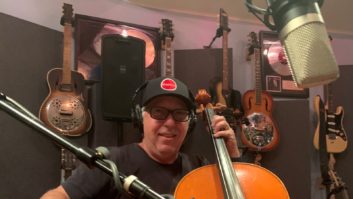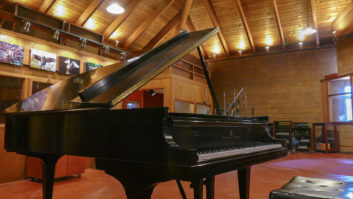
From left: Rivers Cuomo, Brian Bell, Pat Wilson, Scott Shriner
When he first sits down to chat about the making of the new Weezer album, the first thing that drummer Pat Wilson asks is, “Do you think it’s quiet? Do you notice that you have to turn it up to hear it?” I acknowledge that there are definitely quiet sections on it. “I mean overall,” he clarifies. “Most modern records are so loud, and we mastered this one kind of conservatively, at 1990s or late-1980s rock levels. I think the average level is -12, which is unheard of for a modern rock record, although it might become a little bit of a trend. I think people are turning off of music because it’s less musical. When there’s half a dB of dynamic range in a mix, that’s not natural. We don’t hear the world like that. It’s like someone shouting at you the whole time.”
Dynamics certainly abound in the world of Weezer, and over the years they have become known for their quirky, amiable blend of modern and classic rock sounds with lyrics that occasionally veer toward the ironic, and their latest, self-titled effort is no exception. In fact, it is probably their most diverse album yet, from the chugging anthem “Troublemaker” to the Red Hot Chili Peppers-style funk rock of “Everybody Get Dangerous” to the delicate “Heart Songs,” the only ballad you’ll ever hear that name-checks Judas Priest, Iron Maiden and Slayer (not to mention Joan Baez, Devo and ABBA).
The album’s most diverse tune is “The Greatest Man That Ever Lived (Variation on a Shaker Hymn),” which features an old shaker hymn melody — well, it sounded unintentionally close to one, so Weezer frontman and principal songwriter Rivers Cuomo gave them the credit to avoid potential accusations of plagiarism — and in the song the same melody is reiterated through a number of different styles, including hip-hop, Aerosmith, the Andrews sisters, Bach and Beethoven.
“I got the idea to do theme and variations because I was just super-tired of writing verse-chorus-verse songs,” reveals Cuomo. “I wanted to write a song with a completely different kind of structure, so I thought of theme and variations from classical instrumental music. Then I very quickly jotted down the first 11 or 12 genres that I could think of and just went for it.”
The eclectic Red Album, as this third self-titled Weezer album has become known, was recorded in three sessions: four months total between March and September 2007 and two weeks in February 2008. There was a two-month session with producer Rick Rubin at Shangri La in Malibu, Calif., followed by a self-produced two-month session at the Malibu Peforming Arts Center (MPAC). The final sessions with Jacknife Lee at Threshold in Santa Monica, Calif., came about after their label, Geffen, insisted on having more commercial songs on the album, which resulted in the sardonic rocker “Pork and Beans” (ironically, the group’s biggest radio hit ever — it spent more than 10 weeks at Number One on Billboard‘s Hot Modern Rock chart) and “Troublemaker,” which are, in fact, the album’s main radio cuts.
The first stop was Shangri La. “I think that place had a vintage, 32-input API,” recalls drummer Wilson. “Channels were going down all over the place, but it definitely had a vibe. Rivers has a Neve BCM-10 that we usually wind up tracking the drums through anyway. I think there were some outboard APIs and maybe 1081s. It was typical Neve and API stuff.”
As for the MPAC, “That was a large, state-of-the-art, modern theater, and we had the run of several rooms, including the big live room,” Cuomo says. “It was very free-flowing, bright and conducive to creativity and collaboration.”
“The MPAC situation was interesting because they have a control room upstairs from the stage with a gigantic API — literally, 72 channels,” Wilson adds. “It’s ridiculous, but it was unworkable because we couldn’t talk to the engineer up there, so he came down and we monitored off of a Midas front-of-house console. We rented an API 1604, a little sidecar, and again had the BCM-10. We were replicating what we had in Shangri La. It was a lot of fun, actually. We would do a couple of takes and then sit down in the seats behind front of house and listen to the speakers.”
Rubin checked in via e-mail with Weezer while they were at MPAC, but the group was basically on their own to experiment. “It definitely felt like our parents were on vacation and we got the run of the house,” says Cuomo. “I played drums on one song, and Pat played lead guitar and sang [on ‘Automatic’]. It felt very liberating to be on our own.” Further, guitarist Brian Bell wrote and sang on “Thought I Knew,” on which Wilson plays lead and Cuomo drums, while bassist Scott Shriner co-wrote and sang on “Cold Dark World.”
The group definitely worked hard, producing 16 songs (10 of which are on the regular CD; 14 are on the deluxe edition) during the four-and-a-half months of recording. “I certainly wouldn’t say that we slack if there’s no producer there, because we’re all producers,” asserts Cuomo. “When I’m doing my tracks, I’ve got the other three guys there to give me feedback and push me. On top of that, I’m a good worker myself.”
The third and last session was produced by Jacknife Lee at the more traditional Threshold facility, which Cuomo found fun. “They had a vintage Neve with at least 48 channels,” says Wilson. “Pretty much everything went through the Neve on that one. I don’t think there was any API on those two songs.”
The contrast between Rubin and Lee as producers was very distinct, and the band found merits with both. “Working with Jacknife Lee is very invigorating,” Cuomo says. “He’s got a ton of confidence and enthusiasm. He just likes to keep things moving and keep things fresh. It feels like the rest of my band really trusts him, so I’m able to step back a little bit and let them work on their own and get their tracks to where they like them. It seemed to work really efficiently that way.”
Lee also knows how to push people positively. While Wilson was recording his parts for “Troublemaker,” the producer told the drummer that a fill he had played in the chorus would have made him trip on the dancefloor. “I remember thinking, ‘Oh, man, I don’t want to make anybody trip,’” recalls Wilson. “In the past I would’ve been a little bit more standoffish because I always wind up arguing with people at some point, but it made me realize what a badass he was when my first reaction was not to be confrontational. That’s the mark of a good producer, when you immediately have a deep respect [between you].”
“Jacknife is the first guy there and the last to leave,” adds Wilson. “He’s also wicked hands-on and is way into Logic and stuff like that. Rick is on the exact opposite end of the spectrum. He’s a nonmusician with the good ears. For him, sitting in the studio for four or five hours is a total drag. He would rather hear what you’re doing once and comment on it, and then you go back and work through it. You do that until he says, ‘Okay, that’s really great.’”
“Working with Rick is great,” concurs Cuomo. “He’s able to listen to what’s going on and immediately pinpoint the most important thing that needs work.”
In looking at how Weezer’s studio sound has evolved over the years, Cuomo says he feels that the band has a much more musical and sensitive feel today. “On our first record, the Blue Album, it was all we could do to just stay in time and play along to a click track,” he recalls. “It sounded a little mechanical, although powerful. Now we’re able to not use a click track, and it just sounds more musical to me.” (Wilson reveals that the group did use a click for “Pork and Beans” because the chorus is one BPM slower than the verse.)
While there is a lot of overdubbing during the making of a Weezer album, “at the heart of everything we do is a really good live take,” remarks Cuomo. “It also feels like everyone has found a place in our sound where they can flourish and really contribute. The Blue Album sounded more like me controlling everything. I demo’d the songs before I taught them to the guys. It sounded maybe two-dimensional, and now it’s got all these different personalities and sounds like we’re gelling.”
The recording and mixing of the Red Album paralleled the group’s classic-rock influences both sonically and in terms of performance. Engineers this time out included Andrew Scheps, David Schiffman, Dana Nielsen and Tom McFall. Rich Costey mixed the album, aided by engineer Justin Gerrish, at Avatar Studios in New York City. Cuomo says that Wilson is the band’s “sonics” guru, and he was very involved from recording through to mastering. “I became far more interested in the engineering side of stuff,” confirms Wilson, “and a lot of what you hear [on the Red Album] is me trying to preserve the atmosphere around the drums rather than what a lot of people do these days with active rock, which is to close-mike everything and bus-compress the shit out of the drums. Then you bring up the ambience with what’s left over from the overheads. But a lot of these songs have a kick drum mic, a snare drum mic and two faraway overheads. Just by paying attention to how hard you hit the cymbals, you can still play rock that’s got some spirit to it rather than the more focused sound that you hear a lot today. It’s more like Zeppelin but not totally room-based.”
Despite all of the different sessions and people involved, mixer Costey brought it all together in the end. “I think just having one person at the helm during mixing, using all the same gear, [made it] stand a pretty good chance of having it sound cohesive,” muses Cuomo. The band had a meeting with him prior to explain their old-school philosophy, which the mixer was totally on board with. “We threw tracks at him from different sessions with different producers and all different kinds of sounds, but it really came back sounding like an album. Pat was very involved with mixing and making sure that it just didn’t end up sounding like a cookie-cutter modern-rock album. He wanted to make sure that we retained the character of those recording sessions and of this band.”







